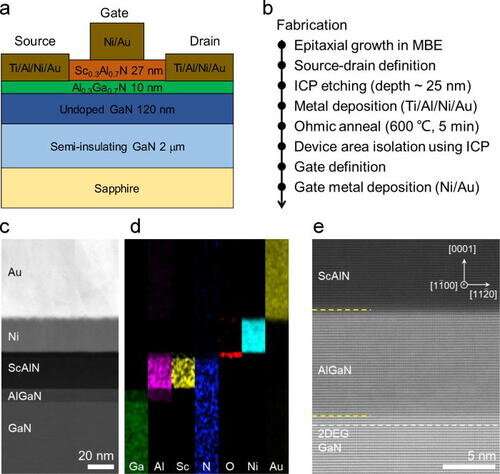New kind of transistor could shrink communications devices on smartphones

One month after announcing a ferroelectric semiconductor at the nanoscale thinness required for modern computing components, a team at the University of Michigan has demonstrated a reconfigurable transistor using that material.
The study is a featured article in Applied Physics Letters.
“By realizing this new type of transistor, it opens up the possibility for integrating multifunctional devices, such as reconfigurable transistors, filters and resonators, on the same platform—all while operating at very high frequency and high power,” said Zetian Mi, U-M professor of electrical and computer engineering who led the research, “That’s a game changer for many applications.”
At its most basic level, a transistor is a kind of switch, letting an electric current through or preventing it from passing. The one demonstrated at Michigan is known as a ferroelectric high electron mobility transistor (FeHEMT)—a twist on the HEMTs that can increase the signal, known as gain, as well as offering high switching speed and low noise. This makes them well suited as amplifiers for sending out signals to cell towers and Wi-Fi routers at high speeds.
Ferroelectric semiconductors stand out from others because they can sustain an electrical polarization, like the electric version of magnetism. But unlike a fridge magnet, they can switch which end is positive and which is negative. In the context of a transistor, this capability adds flexibility—the transistor can change how it behaves.
“We can make our ferroelectric HEMT reconfigurable,” said Ding Wang, a research scientist in electrical and computer engineering and first author of the study. “That means it can function as several devices, such as one amplifier working as several amplifiers that we can dynamically control. This allows us to reduce the circuit area and lower the cost as well as the energy consumption.”
Areas of particular interest for this device are reconfigurable radio frequency and microwave communication as well as memory devices in next-generation electronics and computing systems.
“By adding ferroelectricity to an HEMT, we can make the switching sharper. This could enable much lower power consumption in addition to high gain, making for much more efficient devices,” said Ping Wang, a research scientist in electrical and computer engineering and also the co-corresponding author of the research.
The ferroelectric semiconductor is made of aluminum nitride spiked with scandium, a metal sometimes used to fortify aluminum in performance bicycles and fighter jets. It is the first nitride-based ferroelectric semiconductor, enabling it to be integrated with the next-gen semiconductor gallium nitride. Offering speeds up to 100 times that of silicon, as well as high efficiency and low cost, gallium nitride semiconductors are contenders to displace silicon as the preferred material for electronic devices.
“This is a pivotal step toward integrating nitride ferroelectrics with mainstream electronics,” Mi said.
The new transistor was grown using molecular beam epitaxy, the same approach used to make semiconductor crystals that drive the lasers in CD and DVD players.
More information:
Ding Wang et al, Fully epitaxial, monolithic ScAlN/AlGaN/GaN ferroelectric HEMT, Applied Physics Letters (2023). DOI: 10.1063/5.0143645
Citation:
New kind of transistor could shrink communications devices on smartphones (2023, March 8)
retrieved 8 March 2023
from https://techxplore.com/news/2023-03-kind-transistor-communications-devices-smartphones.html
This document is subject to copyright. Apart from any fair dealing for the purpose of private study or research, no
part may be reproduced without the written permission. The content is provided for information purposes only.
For all the latest Technology News Click Here
For the latest news and updates, follow us on Google News.
